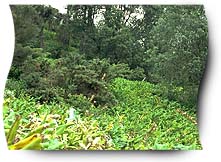|
Invasive weeds - Wild Ginger |
|
Invasive weeds - Wild Ginger |
What is it?
Don't let its good looks fool you. Wild ginger threatens to
smother our native forests.
The plant was introduced to New Zealand from India in the 1890s. It rapidly spread throughout Auckland, Coromandel and Northland. The warm moist climate of the upper North Island helped the initial spread of the plant and it is now a problem in parts of the top of the South Island, and on the West Coast.
Kahili ginger (Hedychium gardnerianum): This plant grows up to two metres in height. It has a large cream flower with long red stamens, is strongly perfumed and produces up to 100 seeds per flower head. Of the two types of wild ginger this is the worst, because of its successful spreading by seed. As well, the plant roots spread outwards and sprout new plants.

Yellow ginger (Hedychium flavescens): This variety has cream flowers in late autumn and early winter. Yellow ginger does not seed and therefore does not multiply as fast as Kahili. It is not as important to remove.
Why is it a problem?
Where wild ginger grows, very little native bush can grow. Both
wild gingers produce massive branching rhizomes. These horizontal
underground stems produce new buds and form a dense layer up to a
metre thick, which invades forest remnants and which other plants
cannot penetrate. Above ground wild ginger blocks the light and
smothers native species. It may permanently displace uncommon plants
or specialised plant communities.

Methods of control
Manual Control: Small seedlings can be pulled out by hand.
Removing the flower heads from Kahili ginger does not kill the plant
but does slow down its spread. If the seeds are not fully formed the
flowers can be left on the ground. If the seeds have formed, remove
the flowers and put them out for disposal in your rubbish bags.
Isolated small plants can be grubbed out and the rhizomes should also
be removed. Stalks and roots are hard to burn and should not be
composted. Take them to your council dump or transfer station or put
them out for domestic rubbish collection. Check with your council if
in doubt.
Chemical Control: The common herbicides that are suitable include Escort, Roundup and Amitrole. Use the concentrations as recommended by the manufacturer. Apply from spring to late autumn. Spray lightly on the leaves and roots. Do not remove the leaves or stalks until they have gone brown and dried out. This will take three to four months.
During spraying, non-target plants can be shielded with cardboard, plastic sheets or a large plastic container. As with all spraying you should read the instructions on the manufacturer's label closely and always wear protective clothing.
For larger plants, the cut stump method can be used. Cut the base of the plant close to the ground with a straight flat cut. The cut must be horizontal so the herbicide will stay on the cut area and be absorbed.
Apply the herbicide as instructed on the label to the stems and roots. Apply immediately, as the sap ceases to flow once the tissues are cut. There are several convenient ways the application can be made, with a paintbrush, eye dropper or a small squeeze bottle. This method uses less spray and reduces the risk to non-target plants. Make sure you leave the plants in the ground until the roots have died off.
Another approach is to cut and remove all stalks and leaves and rake away ground litter to expose the roots. The roots should then be sprayed, covered with leaves, and left. Don't use this method after the flowering heads have formed seeds. The spray will have noticeable effects in three months, but the plant will take 12 to 15 months to fully die and rot.
1. Get hold of some Escort, Roundup or
Amitrole. (Ask Miss Currie or Mrs McMeeken). Carefully read
the instructions on the container about using the
weedkiller. 2. Write instructions for gardeners
wanting to use such a spray, telling them exactly what
precautions they should take. 3. If you want more details, interview an
experienced gardener (try Mrs McMeeken) to find out what
things you have to do to be safe when using dangerous
sprays. .
![]() FOLLOWUP
FOLLOWUP